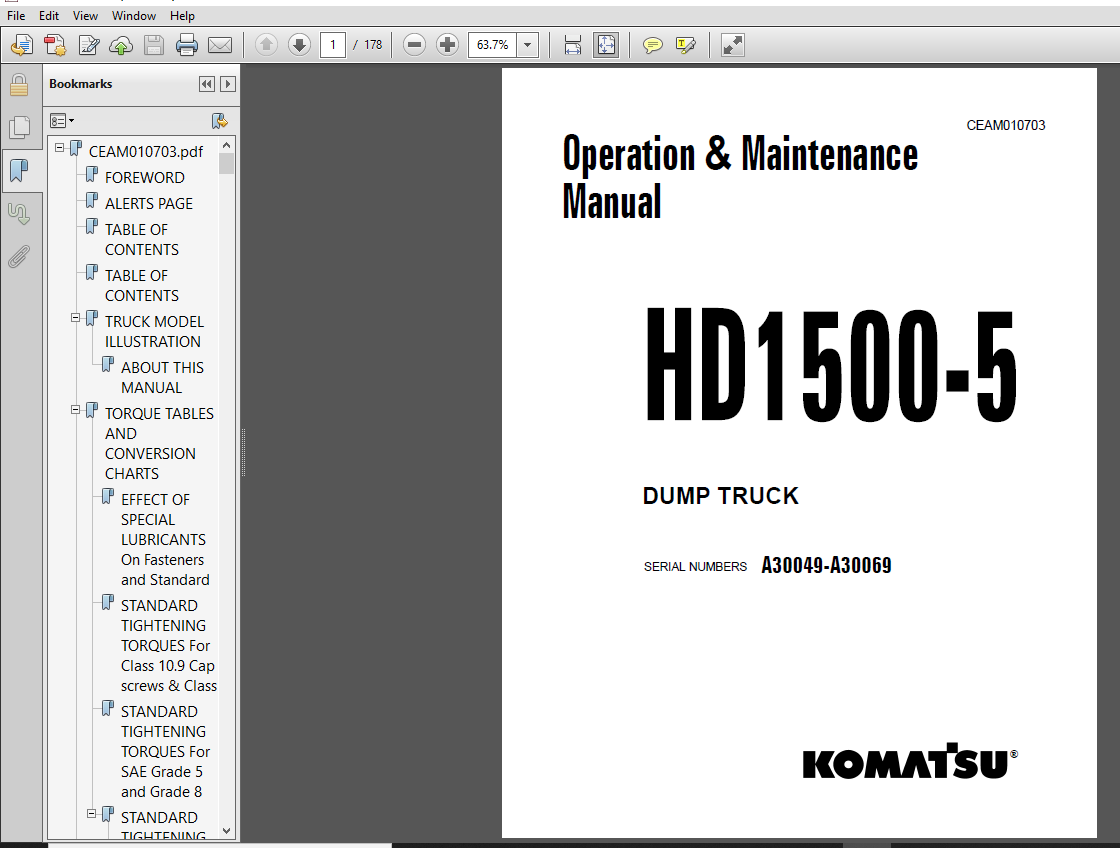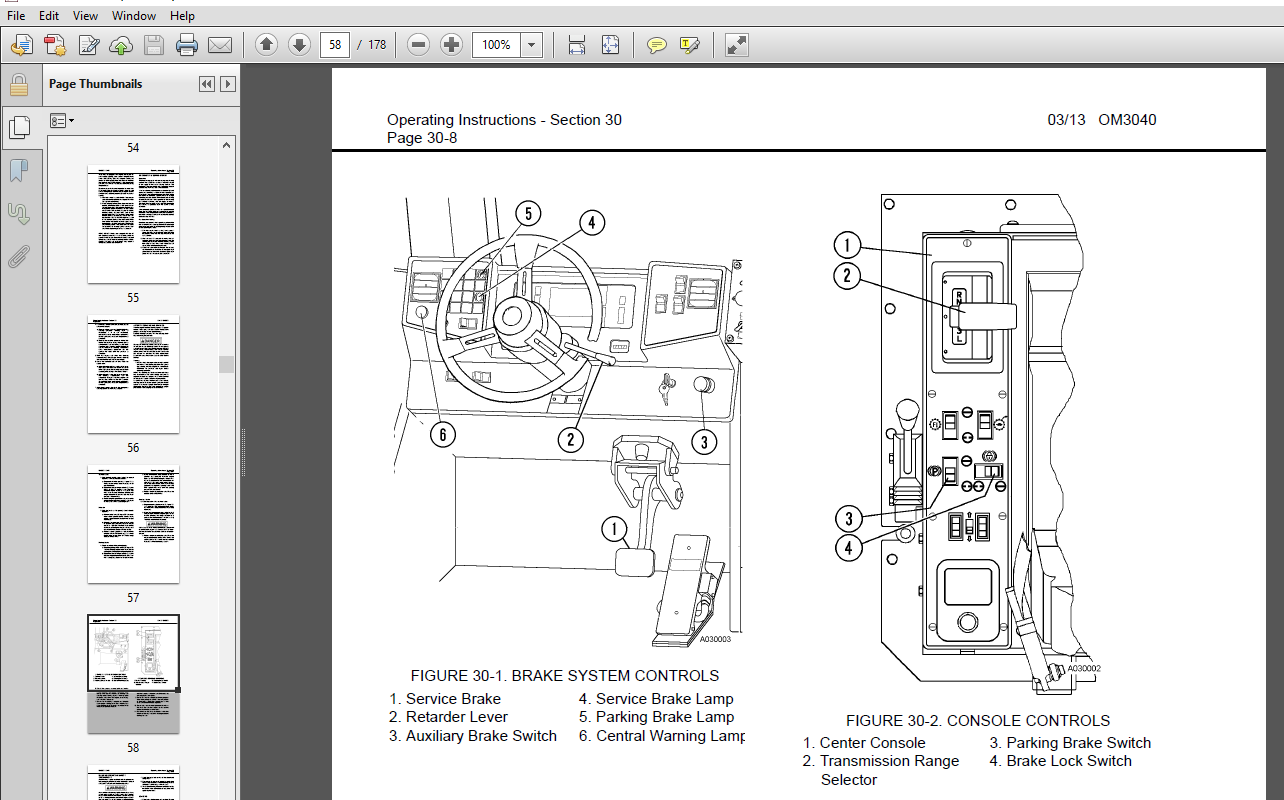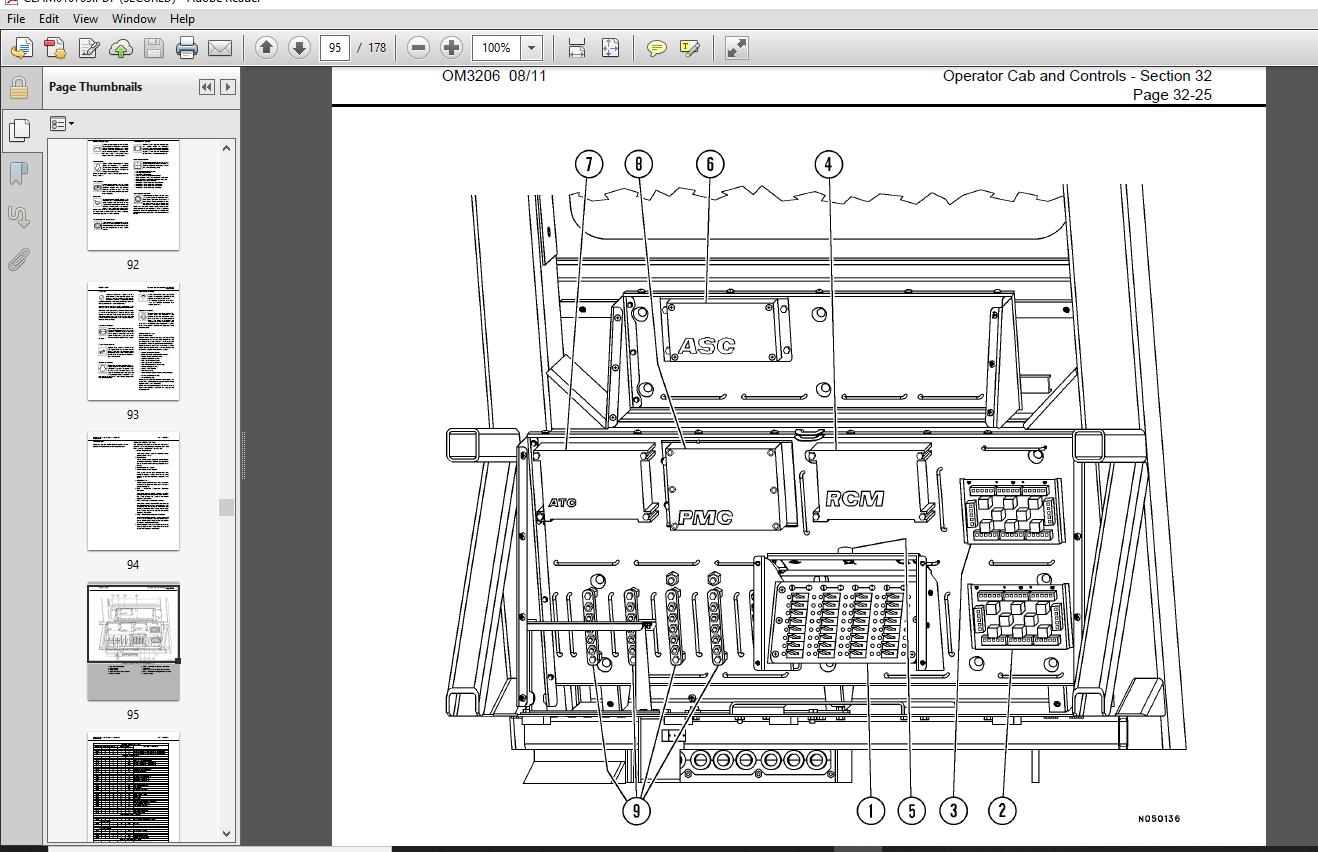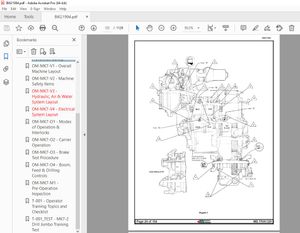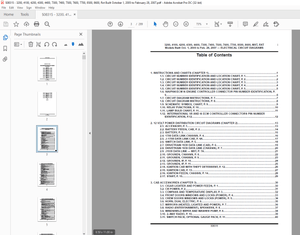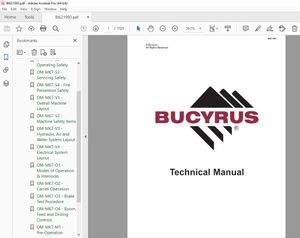Starting from:
$45
Home
Komatsu HD1500-5 Dump Truck Operation & Maintenance Manual SERIAL NUMBERS A30072A30076 PDF DOWNLOAD
Komatsu HD1500-5 Dump Truck Operation & Maintenance Manual SERIAL NUMBERS A30072A30076 PDF DOWNLOAD
Komatsu HD1500-5 Dump Truck Operation & Maintenance Manual
Description:
- Komatsu HD1500-5 Dump Truck Operation & Maintenance Manual
- SERIAL NUMBERS A30072-A30076
- This manual is written for use by the operator and/or the service technician and is designed to help these persons to become fully knowledgeable of the truck and all its systems in order to keep it operating safely and efficiently.
- All operators and maintenance personnel must understand the content in this manual before operating, maintaining or performing operational checks on the truck. All safety notices, warnings and cautions must be understood before operating or repairing the truck.
- The first section is an introduction to the manual and contains a table of contents to locate specific areas of interest. Other sections include Safety, Operation, Maintenance, Specifications, and Optional Equipment. This manual shows dimensioning of metric and (U.S. standard) units throughout.
- All references to right, left, front, or rear are made with respect to the operator’s normal seated position, unless specifically stated otherwise. Standard torque requirements are shown in torque charts in the Introduction section and individual torques are provided in the text in bold face type, such as 135 N·m (100 ft lbs).
- All torque specifications have ±10% tolerance unless otherwise specified. The illustrations used in this manual are typical of the component shown and may not be an exact reproduction of what is found on the truck.
- A product identification plate is located on the frame in front of the right side front wheel and designates the truck model number, product identification number (vehicle serial number), and maximum Gross Vehicle Weight (GVW) rating.
- The product identification number (vehicle serial number) contains information which will identify the original manufacturing bill of material for this unit.
- This complete number will be necessary for proper ordering of many service parts and/or warranty consideration. The GVW is what determines the load on the drive train, frame, tires, and other components.
- The vehicle design and application guidelines are sensitive to the total maximum GVW. GVW is the total truck weight. This is equal to the empty vehicle weight + the fuel & lubricants + the payload.
- To determine allowable payload: Service all lubricants to the proper level including the fuel tank. Weigh the empty truck This includes all accessories, body liners, tailgates, etc. Record this value and subtract from the GVW rating. The result is the allowable payload
Table Of Contents:
- Komatsu HD1500-5 Dump Truck Operation & Maintenance Manual
- SERIAL NUMBERS A30072-A30076
- CEAM013603.pdf.................................................................................... 0 FOREWORD...................................................................................... 5 ALERTS PAGE................................................................................... 6 TABLE OF CONTENTS............................................................................. 7 FOREWARD 10-1................................................................................. 7 TABLE OF CONTENTS 10-3........................................................................ 7 Truck Model Illustration 10-11................................................................ 7 ABOUT THIS MANUAL 10-12....................................................................... 7 STANDARD CHARTS AND TABLES 12-1............................................................... 7 SAFETY 20-1................................................................................... 7 Safety Rules 20-1............................................................................. 7 Safety Features 20-1.......................................................................... 7 Clothing And Personal Items 20-1.............................................................. 7 Unauthorized Modification 20-1................................................................ 7 Leaving The Operator’s Seat 20-1.............................................................. 7 Mounting And Dismounting 20-2................................................................. 7 Fire Prevention For Fuel And Oil 20-2......................................................... 7 Precautions With High Temperature Fluids 20-2................................................. 7 Asbestos Dust Hazard Prevention 20-3.......................................................... 7 Prevention Of Injury By Work Equipment 20-3................................................... 7 Fire Extinguisher And First Aid Kit 20-3...................................................... 7 Precautions For ROPS 20-3..................................................................... 7 Precautions For Attachments 20-3.............................................................. 7 HAUL ROADS 20-4............................................................................... 7 BEFORE STARTING THE ENGINE 20-4............................................................... 7 Fire Prevention 20-5.......................................................................... 7 Preparing For Operation 20-5.................................................................. 7 Ventilation In Enclosed Areas 20-5............................................................ 7 In Operator’s Cab - Before Starting The Engine 20-5........................................... 7 Mirrors, Windows, And Lights 20-5............................................................. 7 OPERATING THE MACHINE 20-6.................................................................... 7 When Starting The Engine 20-6................................................................. 7 Precautions For Starting Machine 20-6......................................................... 7 Truck Operation - General 20-6................................................................ 7 Traveling 20-7................................................................................ 7 Traveling In Reverse 20-7..................................................................... 7 Traveling On Slopes 20-7...................................................................... 7 Ensure Good Visibility 20-7................................................................... 7 Operate Carefully On Snow 20-8................................................................ 7 Avoid Damage To Dump Body 20-8................................................................ 7 Driving Near High Voltage Cables 20-8......................................................... 8 When Dumping 20-8............................................................................. 8 Working On Loose Ground 20-8.................................................................. 8 Loading The Body 20-8......................................................................... 8 Parking The Machine 20-8...................................................................... 8 TOWING 20-9................................................................................... 8 WORKING NEAR BATTERIES 20-9................................................................... 8 Battery Hazard Prevention 20-9................................................................ 8 Starting With Booster Cables 20-9............................................................. 8 PRECAUTIONS FOR MAINTENANCE 20-10............................................................. 8 BEFORE PERFORMING MAINTENANCE 20-10........................................................... 8 Warning Tag 20-10............................................................................. 8 Proper Tools 20-10............................................................................ 8 Stopping The Engine Before Service 20-10...................................................... 8 Securing The Dump Body 20-10.................................................................. 8 DURING MAINTENANCE 20-12...................................................................... 8 Personnel 20-12............................................................................... 8 Attachments 20-12............................................................................. 8 Working Under The Machine 20-12............................................................... 8 Keep The Machine Clean 20-12.................................................................. 8 Rules To Follow When Adding Fuel Or Oil 20-12................................................. 8 Radiator Water Level 20-12.................................................................... 8 Use Of Lighting 20-12......................................................................... 8 Precautions With The Battery 20-13............................................................ 8 Handling High Pressure Hoses 20-13............................................................ 8 Precautions With High Pressure Oil 20-13...................................................... 8 Precautions When Performing Maintenance Near High Temperature Or High Pressure 20-13.......... 8 Rotating Fan And Belts 20-13.................................................................. 8 Waste Materials 20-13......................................................................... 8 TIRES 20-14................................................................................... 8 Handling Tires 20-14.......................................................................... 8 Storing Tires After Removal 20-14............................................................. 8 WHEN REPAIRS ARE NECESSARY 20-15.............................................................. 8 ADDITIONAL JOB SITE RULES 20-16............................................................... 8 WARNINGS AND CAUTIONS 22-1.................................................................... 8 OPERATING INSTRUCTIONS 30-1................................................................... 9 PREPARING FOR OPERATION 30-1.................................................................. 9 Safety Is Thinking Ahead 30-1................................................................. 9 At The Truck - Ground Level Walk Around Inspection 30-1....................................... 9 ENGINE START-UP SAFETY PRACTICES 30-4......................................................... 9 EMERGENCY STEERING SYSTEM 30-5................................................................ 9 Operation 30-5................................................................................ 9 Pre-Operation Testing 30-5.................................................................... 9 AFTER THE ENGINE HAS STARTED 30-6............................................................. 9 MACHINE OPERATION SAFETY PRECAUTIONS 30-9..................................................... 9 LOADING 30-9.................................................................................. 9 HAULING 30-10................................................................................. 9 RETARDER OPERATION 30-10...................................................................... 9 PASSING 30-11................................................................................. 9 DUMPING 30-11................................................................................. 9 Raising the Dump Body 30-12................................................................... 9 Lowering The Dump Body 30-13.................................................................. 9 SAFE PARKING 30-13............................................................................ 9 SHUTDOWN PROCEDURE 30-13...................................................................... 9 SUDDEN LOSS OF ENGINE POWER 30-14............................................................. 9 Emergency Steering And Braking 30-14.......................................................... 9 DISABLED TRUCK DUMPING 30-14.................................................................. 9 Hookup 30-14.................................................................................. 9 Raising the Body 30-14........................................................................ 9 Lowering the Body 30-15....................................................................... 9 DISABLED TRUCK STEERING AND BRAKING 30-16..................................................... 9 TOWING 30-18.................................................................................. 9 OPERATOR CAB AND CONTROLS 32-1................................................................ 9 STEERING WHEEL AND CONTROLS 32-2.............................................................. 9 Horn Button 32-2.............................................................................. 9 Telescope Lock Ring 32-2...................................................................... 9 Tilt Wheel Lever 32-2......................................................................... 9 Turn Signal / Headlight Dimmer 32-2........................................................... 9 Windshield Wiper / Washer Control 32-3........................................................ 9 RETARDER CONTROL LEVER 32-3................................................................... 9 SERVICE BRAKE PEDAL 32-3...................................................................... 9 ACCELERATOR (THROTTLE) PEDAL 32-4............................................................. 9 INSTRUMENT PANEL 32-4......................................................................... 9 HEATER / AIR CONDITIONER COMPARTMENT AND CONTROLS 32-4........................................ 9 Defroster Vent Control Switch 32-4............................................................ 9 Heat Vent Control Switch 32-4................................................................. 9 Fan Control Knob 32-4......................................................................... 10 Temperature Control Knob 32-4................................................................. 10 Air Conditioner Control Switch 32-5........................................................... 10 Heater/Air Conditioner Vents 32-5............................................................. 10 RETARDING CAPACITY CHART 32-5................................................................. 10 Radio Speakers 32-6........................................................................... 10 MOM Display Screen 32-6....................................................................... 10 MOM Dimmer Switch 32-6........................................................................ 10 Warning Alarm Buzzer 32-6..................................................................... 10 Cab Radio 32-6................................................................................ 10 PMC Interface Connector 32-6.................................................................. 10 Air Cleaner Vacuum Gauges 32-6................................................................ 10 Payload Meter 32-6............................................................................ 10 Windshield Wipers 32-6........................................................................ 10 CENTER CONSOLE 32-7........................................................................... 10 Transmission Range Selector 32-8.............................................................. 10 Control Switches 32-9......................................................................... 10 Shift Limiter Switch 32-9..................................................................... 10 F1 Start Switch 32-9.......................................................................... 10 Hoist Control Lever 32-9...................................................................... 10 Parking Brake Switch 32-9..................................................................... 10 Brake Lock Switch 32-10....................................................................... 10 LH Window Control Switch 32-10................................................................ 10 RH Window Control Switch 32-10................................................................ 10 Ash Tray 32-10................................................................................ 10 Lighter 32-10................................................................................. 10 Passenger Seat w/Safety Belt 32-10............................................................ 10 OPERATOR SEAT 32-11........................................................................... 10 Adjustment 32-11.............................................................................. 10 INSTRUMENT PANEL AND INDICATORS 32-12......................................................... 10 Keyswitch 32-13............................................................................... 10 Auxiliary Brake Switch 32-13.................................................................. 10 RH Control/Indicator Panel (Pod) 32-14........................................................ 10 Center Display Panel 32-14.................................................................... 10 LH Control/Indicator Panel (Pod) 32-14........................................................ 10 Ladder Light Switch 32-14..................................................................... 10 Head Light Switch 32-14....................................................................... 10 BackUp/Deck Light Switch 32-14................................................................ 10 RH Control/Indicator Panel (Pod) 32-14........................................................ 10 Cold Weather Starting Aid (Ether Injection) Switch 32-14...................................... 10 Hazard Warning Lights Switch 32-15............................................................ 10 Automatic Idle Selector Switch (AISS) 32-15................................................... 10 Air Conditioner & Heater Vent 32-16........................................................... 11 ASR Cut (Traction Control) Switch (Option) 32-16.............................................. 11 Center Display Panel 32-16.................................................................... 11 Air Pressure Monitor (Not Used) 32-16......................................................... 11 Air Pressure Gauge (Not Used) 32-16........................................................... 11 Coolant Temperature Monitor 32-16............................................................. 11 Engine Cooling Water Temperature Gauge 32-18.................................................. 11 Torque Converter Oil Temperature Monitor 32-18................................................ 11 Torque Converter Oil Temperature Gauge 32-18.................................................. 11 Retarder Oil Temperature Monitor 32-18........................................................ 11 Retarder Oil Temperature Gauge 32-18.......................................................... 11 Left Turn Signal Pilot Lamp 32-18............................................................. 11 High Beam Pilot Lamp 32-18.................................................................... 11 Right Turn Signal Pilot Lamp 32-18............................................................ 11 Speedometer 32-18............................................................................. 11 Tachometer 32-19.............................................................................. 11 Lock-up Pilot Lamp 32-19...................................................................... 11 Shift Limiter Pilot Lamp 32-19................................................................ 11 Shift Indicator 32-19......................................................................... 11 Transmission Shift Position Pilot Lamp 32-19.................................................. 11 Engine Controller Monitor 32-19............................................................... 11 Automatic Transmission Mechatronics Monitor 32-19............................................. 11 Other Mechatronics Monitor (Optional) 32-19................................................... 11 Fuel Level Monitor 32-19...................................................................... 11 Fuel Gauge 32-20.............................................................................. 11 Engine Power Derate Monitor 32-20............................................................. 11 F1 Start Monitor 32-20........................................................................ 11 Auto Cruise Control (Not Used) 32-20.......................................................... 11 ASR Monitor (Optional) 32-20.................................................................. 11 ABS Monitor (Not Used) 32-20.................................................................. 11 Service Meter 32-20........................................................................... 11 Odometer 32-20................................................................................ 11 LH Control/Indicator Panel (Pod) 32-21........................................................ 11 LH Panel/Pod Assembly 32-21................................................................... 11 Engine Oil Temperature 32-21.................................................................. 11 Engine Coolant Level 32-21.................................................................... 11 Low Steering Pressure 32-21................................................................... 11 Accumulator Pre-Charge 32-21.................................................................. 11 Battery Charge Amps 32-22..................................................................... 11 Check Engine 32-22............................................................................ 11 Parking Brake 32-22........................................................................... 11 Body Float 32-22.............................................................................. 11 Transmission Oil Temperature 32-22............................................................ 12 Service Brakes Applied 32-22.................................................................. 12 Maintenance Monitor 32-22..................................................................... 12 Transmission Oil Filters 32-22................................................................ 12 Lamp Test 32-23............................................................................... 12 Low Brake Pressure 32-23...................................................................... 12 Lateral Slope Warning 32-23................................................................... 12 Crankcase Pressure 32-23...................................................................... 12 Panel Dimmer Switch 32-23..................................................................... 12 Engine Oil Pressure 32-23..................................................................... 12 Central Warning Lamp 32-23.................................................................... 12 AC/Heater Vent 32-24.......................................................................... 12 REAR OF OPERATOR CAB 32-24.................................................................... 12 QUANTUM™ FUEL SYSTEM DIAGNOSTICS 32-27........................................................ 12 Determining Fault Codes 32-27................................................................. 12 Exiting The Diagnostics Mode 32-28............................................................ 12 MESSAGE FOR OPERATION AND MAINTENANCE ("MOM") 32-29........................................... 12 Truck Condition- 32-29........................................................................ 12 Production Data During Operation - (Information from the Payload Meter) 32-29................. 12 Transmission Response With Fault Codes 32-33.................................................. 12 Idle Validation Feature 32-34................................................................. 12 CENTER ELECTRONIC DISPLAY PANEL 32-34......................................................... 12 Action Code Display 32-34..................................................................... 12 Cancellation of Action Code 32-35............................................................. 12 LUBRICATION AND SERVICE 40-1.................................................................. 12 COOLANT SPECIFICATIONS 40-1................................................................... 12 Unacceptable Practices 40-1................................................................... 12 QUICK FILL SERVICE CENTER 40-1................................................................ 12 10 HOUR (DAILY) INSPECTION 40-3............................................................... 12 250 HOUR INSPECTION 40-5...................................................................... 12 500 HOUR INSPECTION 40-7...................................................................... 12 1000 HOUR INSPECTION 40-8..................................................................... 12 2000 HOUR INSPECTION 40-9..................................................................... 12 5000 HOUR INSPECTION 40-10.................................................................... 12 RADIATOR FILL PROCEDURE 40-11................................................................. 12 TRANSMISSION OIL LEVEL CHECK 40-11............................................................ 12 HYDRAULIC TANK SERVICE 40-11.................................................................. 12 Filling Instructions 40-11.................................................................... 12 Hydraulic Tank Service 40-12.................................................................. 12 STEERING CIRCUIT FILTER 40-13................................................................. 12 Removal 40-13................................................................................. 13 Installation 40-13............................................................................ 13 HYDRAULIC TANK BREATHER 40-14................................................................. 13 Cleaning 40-14................................................................................ 13 LINCOLN AUTOMATIC LUBRICATION SYSTEM 42-1..................................................... 13 SYSTEM COMPONENTS 42-1........................................................................ 13 System Operation 42-4......................................................................... 13 System Priming 42-5........................................................................... 13 System Checkout 42-6.......................................................................... 13 Pressure Reducer Adjustment 42-6.............................................................. 13 24 VDC Solid State Timer Check 42-7........................................................... 13 24 VDC Solid State Timer Adjustment 42-8...................................................... 13 Injectors (SL-1) 42-8......................................................................... 13 Injector Adjustment 42-8...................................................................... 13 Pump Cycle Timer (Flasher Timer): 42-9........................................................ 13 Pump Cycle Timer (Flasher Timer) Installation 42-9............................................ 13 Pump Cycle Timer (Flasher Timer) Adjustment: 42-9............................................. 13 SYSTEM TROUBLESHOOTING CHART 42-11............................................................ 13 RESERVOIR FILL PROCEDURE 42-13................................................................ 13 Lubricant Required for System 42-13........................................................... 13 Fill Procedure 42-13.......................................................................... 13 PREVENTIVE MAINTENANCE PROCEDURES 42-14....................................................... 13 Daily Lubrication System Inspection 42-14..................................................... 13 250 Hour Inspection 42-14..................................................................... 13 MAJOR COMPONENT DESCRIPTION 50-1.............................................................. 13 PAYLOAD METER III 60-1........................................................................ 13 RADIO / CASSETTE PLAYER 70-1.................................................................. 13 GENERAL RECEIVER FUNCTIONS 70-1............................................................... 13 Turning The Power On And Off 70-1............................................................. 13 Display 70-1.................................................................................. 13 Setting The Default Display 70-1.............................................................. 13 Adjusting Display Brightness 70-1............................................................. 13 SETTING THE TIME 70-2......................................................................... 14 OPERATING THE RADIO 70-2...................................................................... 14 BAND 70-2..................................................................................... 14 TUNE/SEEK 70-2................................................................................ 14 Manual Tuning 70-2............................................................................ 14 SEEK Mode 70-2................................................................................ 14 SCAN 70-2..................................................................................... 14 AUTO 70-2..................................................................................... 14 ADJUSTING THE RECEIVER SETTINGS 70-3.......................................................... 14 PROGRAMMING PRESET STATIONS 70-3.............................................................. 14 OPERATION OF THE WEATHERBAND (U.S.) 70-3...................................................... 14 SATELLITE RADIO 70-4.......................................................................... 14 Operating Satellite Radio 70-4................................................................ 14 Program Type Search (PTY) 70-4................................................................ 14 CASSETTE PLAYER 70-5.......................................................................... 14 Playing A Cassette 70-5....................................................................... 14 Cassette Functions 70-5....................................................................... 14 Programmable Eject Default 70-5............................................................... 14 Bad Tape Detect 70-6.......................................................................... 14 Cleaning The Cassette Player 70-6............................................................. 14 TRUCK MODEL ILLUSTRATION...................................................................... 15 ABOUT THIS MANUAL......................................................................... 16 TORQUE TABLES AND CONVERSION CHARTS........................................................... 17 EFFECT OF SPECIAL LUBRICANTS On Fasteners and Standard Torque Values...................... 18 STANDARD TIGHTENING TORQUES For Class 10.9 Cap screws & Class 10 Nuts..................... 18 STANDARD TIGHTENING TORQUES For SAE Grade 5 and Grade 8 Cap screws........................ 19 STANDARD TIGHTENING TORQUES For SAE Grade 9 Cap screws.................................... 20 Hardware Tightening Method............................................................ 28 SAFETY........................................................................................ 29 Safety Rules.............................................................................. 29 Safety Features........................................................................... 29 Clothing And Personal Items............................................................... 29 Unauthorized Modification................................................................. 29 Leaving The Operator’s Seat............................................................... 29 Mounting And Dismounting.................................................................. 30 Fire Prevention For Fuel And Oil.......................................................... 30 Precautions With High Temperature Fluids.................................................. 30 Asbestos Dust Hazard Prevention........................................................... 30 Prevention Of Injury By Work Equipment.................................................... 31 Fire Extinguisher And First Aid Kit....................................................... 31 Precautions For ROPS...................................................................... 31 Precautions For Attachments............................................................... 31 HAUL ROADS................................................................................ 32 PRECAUTIONS DURING OPERATION.............................................................. 32 BEFORE STARTING THE ENGINE............................................................ 32 Fire Prevention................................................................... 33 Preparing For Operation........................................................... 33 Ventilation In Enclosed Areas..................................................... 33 In Operator’s Cab - Before Starting The Engine.................................... 33 Mirrors, Windows, And Lights...................................................... 33 OPERATING THE MACHINE................................................................. 34 When Starting The Engine.......................................................... 34 Precautions For Starting Machine.................................................. 34 Truck Operation - General......................................................... 34 Traveling......................................................................... 35 Traveling In Reverse.............................................................. 35 Traveling On Slopes............................................................... 35 Ensure Good Visibility............................................................ 35 Operate Carefully On Snow......................................................... 36 Avoid Damage To Dump Body......................................................... 36 Driving Near High Voltage Cables.................................................. 36 When Dumping...................................................................... 36 Working On Loose Ground........................................................... 36 Loading The Body.................................................................. 36 Parking The Machine............................................................... 36 TOWING................................................................................ 37 WORKING NEAR BATTERIES................................................................ 37 Battery Hazard Prevention......................................................... 37 Starting With Booster Cables...................................................... 37 PRECAUTIONS FOR MAINTENANCE............................................................... 38 BEFORE PERFORMING MAINTENANCE......................................................... 38 Warning Tag....................................................................... 38 Proper Tools...................................................................... 38 Stopping The Engine Before Service................................................ 38 Securing The Dump Body............................................................ 38 DURING MAINTENANCE.................................................................... 40 Personnel......................................................................... 40 Attachments....................................................................... 40 Working Under The Machine......................................................... 40 Keep The Machine Clean............................................................ 40 Rules To Follow When Adding Fuel Or Oil........................................... 40 Radiator Water Level.............................................................. 40 Use Of Lighting................................................................... 40 Precautions With The Battery...................................................... 41 Handling High Pressure Hoses...................................................... 41 Precautions With High Pressure Oil................................................ 41 Precautions When Performing Maintenance Near High Temperature Or High Pressure.... 41 Rotating Fan And Belts............................................................ 41 Waste Materials................................................................... 41 TIRES................................................................................. 42 Tire Maintenance.................................................................. 42 Storing Tires After Removal....................................................... 42 WHEN REPAIRS ARE NECESSARY............................................................ 43 ADDITIONAL JOB SITE RULES..................................................................... 44 WARNINGS AND CAUTIONS......................................................................... 45 OPERATING INSTRUCTIONS........................................................................ 51 PREPARING FOR OPERATION................................................................... 51 Safety Is Thinking Ahead.............................................................. 51 At The Truck - Ground Level Walk Around Inspection.................................... 51 ENGINE START-UP SAFETY PRACTICES.......................................................... 54 EMERGENCY STEERING SYSTEM................................................................. 55 Operation............................................................................. 55 Pre-Operation Testing................................................................. 55 AFTER THE ENGINE HAS STARTED.............................................................. 56 MACHINE OPERATION SAFETY PRECAUTIONS...................................................... 59 LOADING................................................................................... 59 HAULING................................................................................... 60 RETARDER OPERATION........................................................................ 60 PASSING................................................................................... 61 DUMPING................................................................................... 61 Raising the Dump Body................................................................. 62 Lowering The Dump Body................................................................ 63 SAFE PARKING.............................................................................. 63 SHUTDOWN PROCEDURE........................................................................ 63 SUDDEN LOSS OF ENGINE POWER............................................................... 64 Emergency Steering And Braking........................................................ 64 DISABLED TRUCK DUMPING.................................................................... 64 Hookup................................................................................ 64 Raising the Body...................................................................... 64 Lowering the Body..................................................................... 65 DISABLED TRUCK STEERING AND BRAKING....................................................... 66 TOWING.................................................................................... 68 OPERATOR CAB AND CONTROLS..................................................................... 71 STEERING WHEEL AND CONTROLS............................................................... 72 Horn Button........................................................................... 72 Telescope Lock Ring................................................................... 72 Tilt Wheel Lever...................................................................... 72 Turn Signal / Headlight Dimmer........................................................ 72 Windshield Wiper / Washer Control..................................................... 73 RETARDER CONTROL LEVER.................................................................... 73 SERVICE BRAKE PEDAL....................................................................... 73 ACCELERATOR (THROTTLE) PEDAL.............................................................. 74 INSTRUMENT PANEL.......................................................................... 74 HEATER / AIR CONDITIONER COMPARTMENT AND CONTROLS......................................... 74 Defroster Vent Control Switch......................................................... 74 Heat Vent Control Switch.............................................................. 74 Fan Control Knob...................................................................... 74 Temperature Control Knob.............................................................. 74 Air Conditioner Control Switch........................................................ 75 Heater/Air Conditioner Vents.......................................................... 75 RETARDING CAPACITY CHART.................................................................. 75 Radio Speakers........................................................................ 76 MOM Display Screen.................................................................... 76 MOM Dimmer Switch..................................................................... 76 Warning Alarm Buzzer.................................................................. 76 Cab Radio............................................................................. 76 PMC Interface Connector............................................................... 76 Air Cleaner Vacuum Gauges............................................................. 76 Payload Meter......................................................................... 76 Windshield Wipers..................................................................... 76 CENTER CONSOLE............................................................................ 77 Transmission Range Selector........................................................... 78 Control Switches...................................................................... 79 Shift Limiter Switch.................................................................. 79 F1 Start Switch....................................................................... 79 Hoist Control Lever................................................................... 79 Parking Brake Switch.................................................................. 79 Brake Lock Switch..................................................................... 80 LH Window Control Switch.............................................................. 80 RH Window Control Switch.............................................................. 80 Ash Tray.............................................................................. 80 Lighter............................................................................... 80 Passenger Seat w/Safety Belt.......................................................... 80 OPERATOR SEAT............................................................................. 80 Seat Belts............................................................................ 80 Adjustment............................................................................ 81 INSTRUMENT PANEL AND INDICATORS............................................................... 82 Keyswitch................................................................................. 83 Auxiliary Brake Switch.................................................................... 83 RH Control/Indicator Panel (Pod).......................................................... 84 Center Display Panel...................................................................... 84 LH Control/Indicator Panel (Pod).......................................................... 84 Ladder Light Switch....................................................................... 84 Head Light Switch......................................................................... 84 BackUp/Deck Light Switch.................................................................. 84 RH Control/Indicator Panel (Pod).......................................................... 84 Cold Weather Starting Aid (Ether Injection) Switch........................................ 84 Hazard Warning Lights Switch.............................................................. 85 Automatic Idle Selector Switch (AISS)..................................................... 85 Air Conditioner & Heater Vent............................................................. 86 ASR Cut (Traction Control) Switch (Option)................................................ 86 Center Display Panel...................................................................... 86 Air Pressure Monitor (Not Used)........................................................... 86 Air Pressure Gauge (Not Used)............................................................. 86 Coolant Temperature Monitor............................................................... 86 Engine Cooling Water Temperature Gauge.................................................... 88 Torque Converter Oil Temperature Monitor.................................................. 88 Torque Converter Oil Temperature Gauge.................................................... 88 Retarder Oil Temperature Monitor.......................................................... 88 Retarder Oil Temperature Gauge............................................................ 88 Left Turn Signal Pilot Lamp............................................................... 88 High Beam Pilot Lamp...................................................................... 88 Right Turn Signal Pilot Lamp.............................................................. 88 Speedometer............................................................................... 88 Tachometer................................................................................ 89 Lock-up Pilot Lamp........................................................................ 89 Shift Limiter Pilot Lamp.................................................................. 89 Shift Indicator........................................................................... 89 Transmission Shift Position Pilot Lamp.................................................... 89 Engine Controller Monitor................................................................. 89 Automatic Transmission Mechatronics Monitor............................................... 89 Other Mechatronics Monitor (Optional)..................................................... 89 Fuel Level Monitor........................................................................ 89 Fuel Gauge................................................................................ 90 Engine Power Derate Monitor............................................................... 90 F1 Start Monitor.......................................................................... 90 Auto Cruise Control (Not Used)............................................................ 90 ASR Monitor (Optional).................................................................... 90 ABS Monitor (Not Used).................................................................... 90 Service Meter............................................................................. 90 Odometer.................................................................................. 90 LH Control/Indicator Panel (Pod).......................................................... 91 LH Panel/Pod Assembly..................................................................... 91 Engine Oil Temperature.................................................................... 91 Engine Coolant Level...................................................................... 91 Low Steering Pressure..................................................................... 91 Accumulator Pre-Charge.................................................................... 91 Battery Charge Amps....................................................................... 92 Check Engine.............................................................................. 92 Parking Brake............................................................................. 92 Body Float................................................................................ 92 Transmission Oil Temperature.............................................................. 92 Service Brakes Applied.................................................................... 92 Maintenance Monitor....................................................................... 92 Transmission Oil Filters.................................................................. 92 Lamp Test................................................................................. 93 Low Brake Pressure........................................................................ 93 Lateral Slope Warning..................................................................... 93 Crankcase Pressure........................................................................ 93 Panel Dimmer Switch....................................................................... 93 Engine Oil Pressure....................................................................... 93 Central Warning Lamp...................................................................... 93 AC/Heater Vent............................................................................ 94 REAR OF OPERATOR CAB...................................................................... 94 CIRCUIT BREAKER CHART..................................................................... 96 QUANTUM™ FUEL SYSTEM DIAGNOSTICS.......................................................... 97 Determining Fault Codes............................................................... 97 Exiting The Diagnostics Mode.......................................................... 98 MESSAGE FOR OPERATION AND MAINTENANCE ("MOM")................................................. 99 Truck Condition-.......................................................................... 99 Production Data During Operation - (Information from the Payload Meter)................... 99 Transmission Response With Fault Codes....................................................103 Idle Validation Feature...................................................................104 CENTER ELECTRONIC DISPLAY PANEL...........................................................104 Action Code Display...................................................................104 Cancellation of Action Code...........................................................105 LUBRICATION AND SERVICE.......................................................................107 COOLANT SPECIFICATIONS....................................................................107 Unacceptable Practices................................................................107 QUICK FILL SERVICE CENTER.................................................................107 10 HOUR (DAILY) INSPECTION................................................................109 250 HOUR INSPECTION.......................................................................111 500 HOUR INSPECTION.......................................................................113 1000 HOUR INSPECTION......................................................................114 2000 HOUR INSPECTION......................................................................115 5000 HOUR INSPECTION......................................................................116 RADIATOR FILL PROCEDURE...................................................................117 TRANSMISSION OIL LEVEL CHECK..............................................................117 HYDRAULIC TANK SERVICE....................................................................117 Filling Instructions..................................................................117 Hydraulic Tank Service................................................................118 STEERING CIRCUIT FILTER...................................................................119 Removal...............................................................................119 Installation..........................................................................119 HYDRAULIC TANK BREATHER...................................................................120 Cleaning..............................................................................120 LINCOLN AUTOMATIC LUBRICATION SYSTEM..........................................................121 SYSTEM COMPONENTS.........................................................................121 System Operation......................................................................124 System Priming........................................................................125 System Checkout.......................................................................126 Pressure Reducer Adjustment...........................................................126 24 VDC Solid State Timer Check........................................................127 24 VDC Solid State Timer Adjustment...................................................128 Injectors (SL-1)......................................................................128 Injector Adjustment...................................................................128 Pump Cycle Timer (Flasher Timer):.....................................................129 Pump Cycle Timer (Flasher Timer) Installation.........................................129 Pump Cycle Timer (Flasher Timer) Adjustment:..........................................129 SYSTEM TROUBLESHOOTING CHART..................................................................131 RESERVOIR FILL PROCEDURE..................................................................133 Lubricant Required for System.........................................................133 Fill Procedure........................................................................133 PREVENTIVE MAINTENANCE PROCEDURES.............................................................134 Daily Lubrication System Inspection.......................................................134 250 Hour Inspection.......................................................................134 MAJOR COMPONENTS AND SPECIFICATIONS...........................................................135 SPECIFICATIONS................................................................................137 SECTION 60....................................................................................139 PAYLOAD METER II - ON BOARD WEIGHING SYSTEM...................................................139 INDEX.........................................................................................139 GENERAL INFORMATION 60-3......................................................................139 Haul Cycles 60-3..............................................................................139 LIGHTS, SWITCHES AND COMPONENTS 60-4..........................................................139 TIPS FOR OPERATION 60-5.......................................................................139 EXTERNAL DISPLAY LIGHTS 60-5..................................................................139 THEORY OF OPERATION 60-6......................................................................139 Basic Description 60-6........................................................................139 Inclinometer 60-6.............................................................................139 Linkage Factor 60-6...........................................................................139 Gain Factor 60- 7.............................................................................139 Brake Lock 60-7...............................................................................139 Sources of Error 60-7.........................................................................139 Typical Data From Service Check Mode 60-7.....................................................139 Example Calculation of Payload 60-8...........................................................139 Viewing Payload Calculation Inputs 60-8.......................................................139 Checking the Gain 60-9........................................................................139 Adjusting the Gain 60-9.......................................................................139 TYPES OF DATA STORED 60-10....................................................................139 Cycle Data 60-10..............................................................................139 Engine ON/OFF Data 60-11......................................................................139 Fault Codes and Warning Data 60-11............................................................139 Engine Operation 60-12........................................................................139 Total Payload and Total Number of Cycles 60-12................................................139 Other Data 60-12..............................................................................139 OPERATOR FUNCTIONS 60-13......................................................................139 Using the Operator Load Counter 60-13.........................................................139 Viewing the Operator Load Counter 60-13.......................................................139 Clearing the Operator Load Counter 60-13......................................................139 Dimming the Lights on the Display 60-13.......................................................139 INITIAL SETUP OF PAYLOAD METER 60-14..........................................................139 Switch Settings 60-14.........................................................................139 Checking the Operator Check Mode 60-15........................................................139 Checking the Service Check Mode 60-15.........................................................139 Checking the Gt setting: 60-16................................................................139 Checking the Inclinometer Settings 60-16......................................................139 Calibrating a Truck 60-16.....................................................................139 DISPLAYS AT START-UP 60-17....................................................................140 Normal Operation 60-17........................................................................140 SETUP AND MAINTENANCE 60-18...................................................................140 Setting The Speed Limit 60-18.................................................................140 Setting the Option Code 60-18.................................................................140 Setting The Machine I.D. Code 60-19...........................................................140 Setting The Operator I.D. Code 60-19..........................................................140 Setting The Time and Date 60-19...............................................................140 DOWNLOAD OF INFORMATION 60-20.................................................................140 DISPLAY OF FAULT CODES 60-20..................................................................140 Monitoring Input Signals 60-24................................................................140 Service Check Mode 60-24......................................................................140 UP FACTOR - PAYLOAD CALCULATION GAIN 60-25....................................................140 PL MODE -LOAD CALCULATION TIMING 60-25........................................................140 FINAL GEAR RATIO SELECTION 60-26..............................................................140 BATTERY REPLACEMENT PROCEDURE 60-27...........................................................140 Replacing the Battery 60-27...................................................................140 After Replacing the Battery 60-28.............................................................140 SUSPENSION PRESSURE SENSOR 60-28..............................................................140 Removal 60-28.................................................................................140 Installation 60-29............................................................................140 INCLINOMETER 60-29............................................................................140 Removal 60-29.................................................................................140 Installation 60-29............................................................................140 Adjustment 60-29..............................................................................140 PAYLOAD METER BACK PANEL 60-30................................................................140 CONNECTIONS 60-31.............................................................................140 PAYLOAD CIRCUIT NUMBERS 60-32.................................................................140 PAYLOAD METER II™ RE-INITIALIZATION PROCEDURE 60-33...........................................140 GENERAL INFORMATION.......................................................................141 Haul Cycles...........................................................................141 LIGHTS, SWITCHES AND COMPONENTS...........................................................142 TIPS FOR OPERATION........................................................................143 EXTERNAL DISPLAY LIGHTS...................................................................143 THEORY OF OPERATION.......................................................................144 Basic Description.....................................................................144 Inclinometer..........................................................................144 Linkage Factor........................................................................144 Gain Factor...........................................................................145 Brake Lock............................................................................145 Sources of Error......................................................................145 Typical Data From Service Check Mode..................................................145 Example Calculation of Payload........................................................146 Viewing Payload Calculation Inputs....................................................146 Checking the Gain.....................................................................147 Adjusting the Gain....................................................................147 TYPES OF DATA STORED......................................................................148 Cycle Data............................................................................148 Engine ON/OFF Data....................................................................149 Fault Codes and Warning Data..........................................................149 Engine Operation......................................................................150 Total Payload and Total Number of Cycles..............................................150 Other Data............................................................................150 OPERATOR FUNCTIONS........................................................................151 Using the Operator Load Counter.......................................................151 Viewing the Operator Load Counter.....................................................151 Clearing the Operator Load Counter....................................................151 Dimming the Lights on the Display.....................................................151 INITIAL SETUP OF PAYLOAD METER............................................................152 Switch Settings.......................................................................152 Checking the Operator Check Mode......................................................153 Checking the Service Check Mode.......................................................153 Checking the Gt setting:..............................................................154 Checking the Inclinometer Settings....................................................154 Calibrating a Truck...................................................................154 DISPLAYS AT START-UP......................................................................155 Normal Operation......................................................................155 SETUP AND MAINTENANCE.....................................................................156 Setting The Speed Limit...............................................................156 Setting the Option Code...............................................................156 Setting The Machine I.D. Code.........................................................157 Setting The Operator I.D. Code........................................................157 Setting The Time and Date.............................................................157 DOWNLOAD OF INFORMATION...................................................................158 DISPLAY OF FAULT CODES....................................................................158 Monitoring Input Signals..............................................................162 Service Check Mode....................................................................162 UP FACTOR - PAYLOAD CALCULATION GAIN......................................................163 PL MODE -LOAD CALCULATION TIMING..........................................................163 FINAL GEAR RATIO SELECTION................................................................164 BATTERY REPLACEMENT PROCEDURE.............................................................165 Replacing the Battery.................................................................165 After Replacing the Battery...........................................................166 SUSPENSION PRESSURE SENSOR................................................................166 Removal...............................................................................166 Installation..........................................................................167 INCLINOMETER..............................................................................167 Removal...............................................................................167 Installation..........................................................................167 Adjustment............................................................................167 PAYLOAD METER BACK PANEL..................................................................168 CONNECTIONS...............................................................................169 PAYLOAD CIRCUIT NUMBERS.......................................................................170 PAYLOAD METER II™ RE-INITIALIZATION PROCEDURE.................................................171 RADIO / CASSETTE PLAYER.......................................................................173 GENERAL RECEIVER FUNCTIONS................................................................173 Turning The Power On And Off..........................................................173 Display...............................................................................173 Setting The Default Display...........................................................173 Adjusting Display Brightness..........................................................173 SETTING THE TIME..........................................................................174 OPERATING THE RADIO.......................................................................174 BAND..................................................................................174 TUNE/SEEK.............................................................................174 Manual Tuning.........................................................................174 SEEK Mode.............................................................................174 SCAN..................................................................................174 AUTO..................................................................................174 ADJUSTING THE RECEIVER SETTINGS...........................................................175 PROGRAMMING PRESET STATIONS...............................................................175 OPERATION OF THE WEATHERBAND (U.S.).......................................................175 SATELLITE RADIO...........................................................................176 Operating Satellite Radio.............................................................176 Program Type Search (PTY).............................................................176 CASSETTE PLAYER...........................................................................177 Playing A Cassette....................................................................177 Cassette Functions....................................................................177 Programmable Eject Default............................................................177 Bad Tape Detect.......................................................................178 Cleaning The Cassette Player..........................................................178
Screenshot Of The Manual:
1 file (1.6MB)

